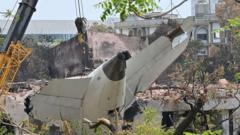As aviation experts gather to investigate the tragic crash of Air India Flight AI171 shortly after takeoff, speculation surrounding the causes includes potential engine failure and configuration errors. With a meticulous examination underway, critical factors such as bird strikes, fuel contamination, and mechanical anomalies are being closely analyzed to unravel the mystery behind the disaster.
Enigmatic Circumstances Surround Air India Plane Crash Shortly After Takeoff

Enigmatic Circumstances Surround Air India Plane Crash Shortly After Takeoff
Investigators probe the baffling crash of Air India Flight AI171, seeking answers to the catastrophic failure that claimed 241 lives.
A sudden tragedy struck the skies as Air India Flight AI171 crashed just moments after takeoff from Ahmedabad, India, on Thursday afternoon, claiming the lives of 241 passengers and crew aboard. The Boeing 787-8 Dreamliner was on a routine flight to London Gatwick when it met with disaster, just 1.5 kilometers from the runway at Sardar Vallabhbhai Patel International Airport. The incident has prompted an urgent investigation, involving Indian aviation authorities and experts from the U.S. and UK.
The circumstances surrounding this crash, marking the first fatal incident for the 787-8 Dreamliner since its entry into commercial service in 2011, are puzzling and require thorough analysis. Witnesses recount that the aircraft struggled to gain altitude almost immediately after takeoff, leading to a mayday call from the cockpit, shortly followed by an explosive crash into a residential area. Eyewitness footage corroborates this, showing the aircraft in a seemingly perilous descent within seconds of its takeoff.
Pilot experience could not mitigate the tragedy. Captain Sumeet Sabharwal and co-pilot Clive Kundar, with a combined flying history exceeding 9,000 hours, couldn't avert the crisis. Reports indicate that the flight took off with a full fuel load of around 100 tonnes, a factor that may have complicated the aircraft's performance right after departure.
Several critical aspects are under investigation, including a rare occurrence of a double engine failure, which might have resulted from fuel contamination or blockages within the complex fuel system. One pilot emphasized that if both engines failed simultaneously, the crew would have had minimal time to respond to rectify the situation effectively.
Bird strikes have also surfaced as a potential cause, particularly given Ahmedabad's notorious background for such incidents, exemplified by previous occurrences affecting aircraft in the surrounding region. Experts suggest that a bird strike severe enough to impact engine performance, especially with a low altitude threshold and limited time for recovery, could lead to catastrophic outcomes.
Additionally, speculation surrounds the configuration of the aircraft's flaps, which are crucial for maximizing lift during takeoff. In high-temperature conditions, such as those above 40°C experienced during the flight, inadequate flap extension could hinder the aircraft's ability to ascend properly, suggesting a mechanical failure or human error during preparation for lift-off.
As investigators scrutinize black box data and debris, this complex inquiry will necessitate deliberation over numerous contributing factors, illuminating whether human oversight, technical failures, or situational dangers compounded this aviation calamity. The aviation community watches closely as findings emerge from this grave incident, which will undoubtedly have repercussions for aviation safety protocols and operations worldwide.




















